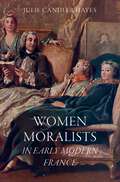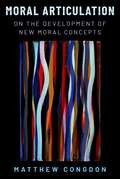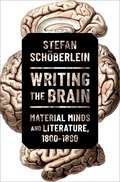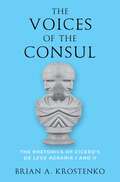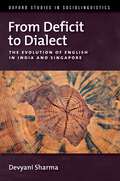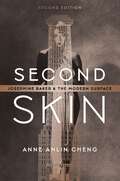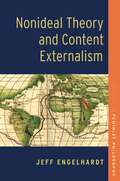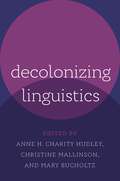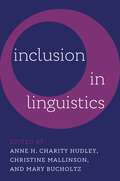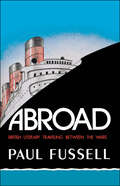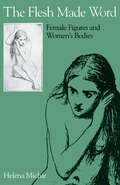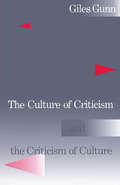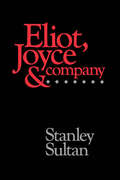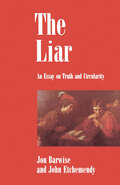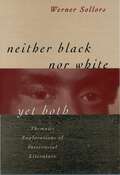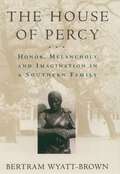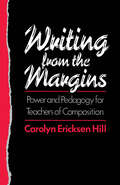- Table View
- List View
Women Moralists in Early Modern France
by Julie Candler HayesEarly modern women writers left their mark in multiple domains--novels, translations, letters, history, and science. Although recent scholarship in literary and cultural studies has enriched our understanding of these accomplishments, less attention has been paid to other forms of women's writing. Women Moralists in Early Modern France explores the contributions of seventeenth and eighteenth-century French women philosophers and intellectuals to moralist writing, the observation of human motives and behavior. This distinctively French genre draws on philosophical and literary traditions extending back to classical antiquity. Moralist short forms such as the maxim, dialogue, character portrait, and essay engage social and political questions, epistemology, moral psychology, and virtue ethics. Although moralist writing was closely associated with the salon culture in which women played a major role, women's contributions to the genre have received scant scholarly attention. Julie Candler Hayes examines major moralist writers such as Madeleine de Scud?ry, Anne-Th?r?se de Lambert, ?milie Du Ch?telet, and Germaine de Sta?l, as well as nearly two dozen of their contemporaries. Their reflections range from traditional topics such as the nature of the self, friendship, happiness, and old age, to issues that were very much part of their own lifeworld, such as the institution of marriage and women's nature and capabilities. Each chapter traces the evolution of women's moralist thought on a given topic from the late seventeenth century to the Enlightenment and the decades immediately following the French Revolution, a period of tremendous change in the horizon of possibilities for women as public figures and intellectuals. Hayes demonstrates how, through their critique of institutions and practices, their valorization of introspection and self-expression, and their engagement with philosophical issues, women moralists carved out an important space for the public exercise of their reason.
Moral Articulation: On the Development of New Moral Concepts
by Matthew CongdonThis book explores the historical development of new moral concepts. Starting from examples of new moral terms invented in the twentieth century, like 'sexual harassment', 'genocide', 'racism', and 'hate speech', this book asks: what we are doing when we bring ethically significant acts and events under new descriptions? Are we simply naming moral phenomena that already exist, fully formed and intact, prior to their expression in language? Or are moral phenomena sensitive to the descriptions under which they fall, such that new modes of moral expression can reshape the phenomena they bring to light? Moral Articulation outlines an ethical framework that allows us to embrace a version of the latter, transformative view without sacrificing notions of moral truth, objectivity, and knowledge. The book presents a view of moral meaningfulness as extending beyond what we can presently put into words, urging that expansions in our moral vocabularies often begin in dissonant experiences of conceptual and linguistic limits. Resisting a tendency in contemporary ethics to start with situations and dilemmas whose descriptions are already given, this book argues that the struggle to piece together a discursively articulate picture of a situation is an ethical task in its own right. The result is a picture of ethical life that emphasizes the role of language in shaping who we are.
Moral Articulation: On the Development of New Moral Concepts
by Matthew CongdonThis book explores the historical development of new moral concepts. Starting from examples of new moral terms invented in the twentieth century, like 'sexual harassment', 'genocide', 'racism', and 'hate speech', this book asks: what we are doing when we bring ethically significant acts and events under new descriptions? Are we simply naming moral phenomena that already exist, fully formed and intact, prior to their expression in language? Or are moral phenomena sensitive to the descriptions under which they fall, such that new modes of moral expression can reshape the phenomena they bring to light? Moral Articulation outlines an ethical framework that allows us to embrace a version of the latter, transformative view without sacrificing notions of moral truth, objectivity, and knowledge. The book presents a view of moral meaningfulness as extending beyond what we can presently put into words, urging that expansions in our moral vocabularies often begin in dissonant experiences of conceptual and linguistic limits. Resisting a tendency in contemporary ethics to start with situations and dilemmas whose descriptions are already given, this book argues that the struggle to piece together a discursively articulate picture of a situation is an ethical task in its own right. The result is a picture of ethical life that emphasizes the role of language in shaping who we are.
Writing the Brain: Material Minds and Literature, 1800-1880
by Stefan SchöberleinIn the nineteenth century, American and British culture experienced an explosion of interest in writings about the brain. The years between 1800 and 1880 are often described as the emergence of modern neuroscience, with new areas of the brain being discovered and named. Naming was quickly followed by a drive to hypothesize functioning, a process that suggested thinking itself may be a mere physiological act. In Writing the Brain, Stefan Schöberlein tracks how literature encountered such novel, scientific theories of cognition-and how it, in turn, shaped scientific thinking. Before the era of modern psychology, a heterogeneous group of alienists, self-help gurus, and anatomists proposed that the structure of the brain could be used to explain how the mind worked. Suddenly, nineteenth-century readers and writers had to contend with the idea that qualities once ascribed to disembodied souls may arise from a mere lump of cranial matter. In a period when scientists and literary writers frequently published in the same periodicals, the ensuing debate over the material mind was a public one. Writing the Brain demonstrates, by examining several canonical works and textual rediscoveries, that these exchanges not only influenced how poets and novelists fictionalized the mind but also how scientists thought and talked about their discoveries. From George Combe to Charles Dickens, from Emily Dickinson to Pliny Earle, from Benjamin Rush to Alfred Tennyson, 1800s debated what it means to have or, rather, be a brain.
Writing the Brain: Material Minds and Literature, 1800-1880
by Stefan SchöberleinIn the nineteenth century, American and British culture experienced an explosion of interest in writings about the brain. The years between 1800 and 1880 are often described as the emergence of modern neuroscience, with new areas of the brain being discovered and named. Naming was quickly followed by a drive to hypothesize functioning, a process that suggested thinking itself may be a mere physiological act. In Writing the Brain, Stefan Schöberlein tracks how literature encountered such novel, scientific theories of cognition-and how it, in turn, shaped scientific thinking. Before the era of modern psychology, a heterogeneous group of alienists, self-help gurus, and anatomists proposed that the structure of the brain could be used to explain how the mind worked. Suddenly, nineteenth-century readers and writers had to contend with the idea that qualities once ascribed to disembodied souls may arise from a mere lump of cranial matter. In a period when scientists and literary writers frequently published in the same periodicals, the ensuing debate over the material mind was a public one. Writing the Brain demonstrates, by examining several canonical works and textual rediscoveries, that these exchanges not only influenced how poets and novelists fictionalized the mind but also how scientists thought and talked about their discoveries. From George Combe to Charles Dickens, from Emily Dickinson to Pliny Earle, from Benjamin Rush to Alfred Tennyson, 1800s debated what it means to have or, rather, be a brain.
The Voices of the Consul: The Rhetorics of Cicero's de lege agraria I and II
by Brian A. KrostenkoThe Voices of the Consul is the first book-length study of the rhetoric of "On the Agrarian Law" I and II, the first two speeches that the great Roman orator Cicero gave on his ascension to the leadership of the Roman state-the first to the senate, the second to the people. Through a close and novel linguistic analysis, Brian A. Krostenko draws out Cicero's idealistic visions and shows how Cicero's apparently diffuse attacks on various clauses of an agrarian bill are informed by a consistent and idealistic vision of the functioning of the Roman state in which the people are to take their sovereignty seriously and the senate is to regard its high position responsibly. Cicero's speeches turned a critique of a single law into a politico manifesto-a worthy objective for a new consul. By a close comparison of corresponding passages from the speeches, the book clarifies Cicero's masterful adaptations of his audiences' knowledge of political concepts, civic spaces, legal procedures, and other cultural practices. By revealing Cicero's rhetorical technique and the ideology implicit in these speeches, The Voices of the Consul provides a more complete picture of his understanding of Roman politics and his own role within it at the beginning of his consular career.
From Deficit to Dialect: The Evolution of English in India and Singapore (Oxford Studies in Sociolinguistics)
by Devyani SharmaThe emergence of new English dialects in postcolonial regions has transformed the politics of English in the world and language ecologies in many regions. Why, how, and when did these dialects develop? Why do they have the accents and grammars that we hear? Are the grammars of these dialects completely different due to the influence of local languages, or similar due to natural tendencies in human cognition? In terms of social identity, do these new speakers behave like native speakers of British or American English, or like language learners? Focusing on two prominent cases; English in India and in Singapore; this book examines the social, historical, and cognitive forces that together created and continue to shape these dialects. Differences in the linguistic ecology of the two regions help us to identify the strongest mechanisms of dialect formation under long-term cultural contact. The multi-scale analysis of a range of bilinguals moves beyond a simplistic divide between 'deficit' and 'dialect' views of these speech communities, showing that change proceeds unevenly across the language system and the social group, with feedback loops between social history, language learning, language structure, and identity.
Second Skin: Josephine Baker and the Modern Surface
by Anne Anlin ChengThrough the figure of Josephine Baker, Second Skin tells the story of an unexpected yet enduring intimacy between the invention of a modernist style and the theatricalization of black skin at the turn of the twentieth century. Stepping outside of the platitudes surrounding this iconic figure, Anne A. Cheng argues that Baker's famous nakedness must be understood within larger philosophic and aesthetic debates about, and desire for, 'pure surface' that crystallized at the convergence of modern art, architecture, machinery, and philosophy. Through Cheng's analysis, Baker emerges as a central artist whose work engages with and impacts various modes of modernist display such as film, photography, art, and even the modern house.
Second Skin: Josephine Baker and the Modern Surface
by Anne Anlin ChengThrough the figure of Josephine Baker, Second Skin tells the story of an unexpected yet enduring intimacy between the invention of a modernist style and the theatricalization of black skin at the turn of the twentieth century. Stepping outside of the platitudes surrounding this iconic figure, Anne A. Cheng argues that Baker's famous nakedness must be understood within larger philosophic and aesthetic debates about, and desire for, 'pure surface' that crystallized at the convergence of modern art, architecture, machinery, and philosophy. Through Cheng's analysis, Baker emerges as a central artist whose work engages with and impacts various modes of modernist display such as film, photography, art, and even the modern house.
Nonideal Theory and Content Externalism (Studies in Feminist Philosophy)
by Jeff EngelhardtThis book charges that just about every philosophical theory of mind or language developed over the past 50 years in the West is systematically inaccurate. Systemic oppression has influenced the processes that theories of mind or language purport to identify; however, that same systemic oppression has also made it so that most middle-to-upper class White men (including most philosophers of mind or language) are ignorant of systemic oppression. Consequently, most theories of mind or language are systematically inaccurate because they fail to account for the influences of systemic oppression. Philosopher Jeff Engelhardt argues for the de-idealization of two influential theories in the philosophy of mind and language--social externalism and objective type externalism--and considers some consequences of the de-idealization project. Following the work of Charles Mills, Engelhardt argues that ideal theories adopt oppression-obscuring assumptions while nonideal theories avoid them (or at least try to). Ideal theories assume that language users are basically equal, and that social institutions and structures are basically just, but scholarship on Western social relations, institutions, and structures shows that in fact each of these is systematically influenced by oppression. Consequently, ideal theories tend to be systematically inaccurate. Moreover, since oppression systematically produces ignorance of systemic oppression, such systematically inaccurate theories are likely the norm rather than the exception. Engelhardt shows that once we've shown that oppression systematically influences the processes that determine linguistic meanings (according to content externalism), then we have reason to expand our notion of hermeneutical injustice, we have evidence that hermeneutical injustice occurs systematically, and we have grounds for expanding discussions of conceptual engineering to include questions about engineering the processes that determine concepts, not just concepts themselves.
Nonideal Theory and Content Externalism (Studies in Feminist Philosophy)
by Jeff EngelhardtThis book charges that just about every philosophical theory of mind or language developed over the past 50 years in the West is systematically inaccurate. Systemic oppression has influenced the processes that theories of mind or language purport to identify; however, that same systemic oppression has also made it so that most middle-to-upper class White men (including most philosophers of mind or language) are ignorant of systemic oppression. Consequently, most theories of mind or language are systematically inaccurate because they fail to account for the influences of systemic oppression. Philosopher Jeff Engelhardt argues for the de-idealization of two influential theories in the philosophy of mind and language--social externalism and objective type externalism--and considers some consequences of the de-idealization project. Following the work of Charles Mills, Engelhardt argues that ideal theories adopt oppression-obscuring assumptions while nonideal theories avoid them (or at least try to). Ideal theories assume that language users are basically equal, and that social institutions and structures are basically just, but scholarship on Western social relations, institutions, and structures shows that in fact each of these is systematically influenced by oppression. Consequently, ideal theories tend to be systematically inaccurate. Moreover, since oppression systematically produces ignorance of systemic oppression, such systematically inaccurate theories are likely the norm rather than the exception. Engelhardt shows that once we've shown that oppression systematically influences the processes that determine linguistic meanings (according to content externalism), then we have reason to expand our notion of hermeneutical injustice, we have evidence that hermeneutical injustice occurs systematically, and we have grounds for expanding discussions of conceptual engineering to include questions about engineering the processes that determine concepts, not just concepts themselves.
Decolonizing Linguistics
by Mary Bucholtz Christine Mallinson Anne H. Charity HudleyThis is an open access title available under the terms of a CC BY-NC-ND 4.0 International license. It is free to read at Oxford Academic and offered as a free PDF download from OUP and selected open access locations. Decolonizing Linguistics, the companion volume to Inclusion in Linguistics, is designed to uncover and intervene in the history and ongoing legacy of colonization and colonial thinking in linguistics and related fields. Taken together, the two volumes are the first comprehensive, action-oriented, book-length discussions of how to advance social justice in all aspects of the discipline. The introduction to Decolonizing Linguistics theorizes decolonization as the process of centering Black, Native, and Indigenous perspectives, describes the extensive dialogic and collaborative process through which the volume was developed, and lays out key principles for decolonizing linguistic research and teaching. The twenty chapters cover a wide range of languages and linguistic contexts (e.g., Bantu languages, Creoles, Dominican Spanish, Francophone Africa, Zapotec) as well as various disciplines and subfields (applied linguistics, communication, historical linguistics, language documentation and revitalization/reclamation, psycholinguistics, sociolinguistics, syntax). Contributors address such topics as refusing settler-colonial practices and centering community goals in research on Indigenous languages; decolonizing research partnerships between the Global South and the Global North; and prioritizing Black Diasporic perspectives in linguistics. The volume's conclusion lays out specific actions that linguists can take through research, teaching, and institutional structures to refuse coloniality in linguistics and to move the field toward a decolonized future.
Decolonizing Linguistics
by Mary Bucholtz Christine Mallinson Anne H. Charity HudleyThis is an open access title available under the terms of a CC BY-NC-ND 4.0 International license. It is free to read at Oxford Academic and offered as a free PDF download from OUP and selected open access locations. Decolonizing Linguistics, the companion volume to Inclusion in Linguistics, is designed to uncover and intervene in the history and ongoing legacy of colonization and colonial thinking in linguistics and related fields. Taken together, the two volumes are the first comprehensive, action-oriented, book-length discussions of how to advance social justice in all aspects of the discipline. The introduction to Decolonizing Linguistics theorizes decolonization as the process of centering Black, Native, and Indigenous perspectives, describes the extensive dialogic and collaborative process through which the volume was developed, and lays out key principles for decolonizing linguistic research and teaching. The twenty chapters cover a wide range of languages and linguistic contexts (e.g., Bantu languages, Creoles, Dominican Spanish, Francophone Africa, Zapotec) as well as various disciplines and subfields (applied linguistics, communication, historical linguistics, language documentation and revitalization/reclamation, psycholinguistics, sociolinguistics, syntax). Contributors address such topics as refusing settler-colonial practices and centering community goals in research on Indigenous languages; decolonizing research partnerships between the Global South and the Global North; and prioritizing Black Diasporic perspectives in linguistics. The volume's conclusion lays out specific actions that linguists can take through research, teaching, and institutional structures to refuse coloniality in linguistics and to move the field toward a decolonized future.
Inclusion in Linguistics
by Mary Bucholtz Christine Mallinson Anne H. Charity HudleyThis is an open access title available under the terms of a CC BY-NC-ND 4.0 International license. It is free to read at Oxford Academic and offered as a free PDF download from OUP and selected open access locations. Inclusion in Linguistics, the companion volume to Decolonizing Linguistics, aims to reinvent linguistics as a space of belonging across race, gender, class, disability, geographic region, and more. Taken together, the two volumes are the first comprehensive, action-oriented, book-length discussions of how to advance social justice in all aspects of the discipline. The volume's introduction theorizes inclusion as fundamental to social justice and describes the extensive dialogic and collaborative process through which the volume was developed. Contributors discuss intersectional forms of exclusion in linguistics: researchers' anti-autistic ableism; the exclusion of Deaf Global South researchers of color; the marginalization of Filipino American students and scholars; disciplinary transphobia; and the need for a ?big tent? linguistics. The volume goes on to outline intersectional forms of exclusion in linguistics, describes institutional steps toward inclusion, offers examples of how to further educational justice, and shares models of collaborations designed to create an inclusive public-facing linguistics. The volume's conclusion outlines actions that linguists can take through research, teaching, and institutional structures to advance inclusion in linguistics and move the field toward social justice.
Inclusion in Linguistics
by Anne H. Charity Hudley, Christine Mallinson, and Mary Bucholtz 2024This is an open access title available under the terms of a CC BY-NC-ND 4.0 International license. It is free to read at Oxford Academic and offered as a free PDF download from OUP and selected open access locations. Inclusion in Linguistics, the companion volume to Decolonizing Linguistics, aims to reinvent linguistics as a space of belonging across race, gender, class, disability, geographic region, and more. Taken together, the two volumes are the first comprehensive, action-oriented, book-length discussions of how to advance social justice in all aspects of the discipline. The volume's introduction theorizes inclusion as fundamental to social justice and describes the extensive dialogic and collaborative process through which the volume was developed. Contributors discuss intersectional forms of exclusion in linguistics: researchers' anti-autistic ableism; the exclusion of Deaf Global South researchers of color; the marginalization of Filipino American students and scholars; disciplinary transphobia; and the need for a ?big tent? linguistics. The volume goes on to outline intersectional forms of exclusion in linguistics, describes institutional steps toward inclusion, offers examples of how to further educational justice, and shares models of collaborations designed to create an inclusive public-facing linguistics. The volume's conclusion outlines actions that linguists can take through research, teaching, and institutional structures to advance inclusion in linguistics and move the field toward social justice.
Abroad: British Literary Traveling between the Wars
by Paul FussellA book about the meaning of travel, about how important the topic has been for writers for two and a half centuries, and about how excellent the literature of travel happened to be in England and America in the 1920s and 30s.
The Flesh Made Word: Female Figures and Women's Bodies
by Helena MichieHelena Michie's provocative new work looks at how women's bodies are portrayed in a variety of Victorian literary and non-literary genres--from painting, poems, and novels, to etiquette, books, sex manuals, and pornography. After identifying a series of codes and taboos that govern the depiction of women in such activities as eating and working, she then turns to the physical descriptions of Victorian heroines, focusing on those parts of their bodies that are erased, and on those that become fetishized in conventional description. Her vivid analysis moves forward in time with a consideration of 20th-century "second wave" feminism and a discussion of the poetics of the body as articulated by feminist writers on both sides of the Atlantic. Making use of feminist, poststructuralist, and psychoanalytic accounts of the figure of woman, and the relation of the body to the text, The Flesh Made Word offers fresh readings of works by writers as diverse as the Brontës, Dickens, Eliot, Gaskell, Trollope, Hardy, Adrienne Rich, Olga Broumas, Audre Lorde, and Louise Gluck.
The Culture of Criticism and the Criticism of Culture
by Giles GunnGiles Gunn's important new work is at once a provocative defense of the kind of moral reflection once associated in America with the writings of Lionel Trilling and Edmund Wilson and an acknowledgement that this pragmatic legacy must be reevaluated in the light of challenges posed by structuralist and post-structuralist theory. Including detailed discussions of such thinkers as Kenneth Burke, Clifford Geertz, Mikhail Bakhtin, Richard Rorty, Trilling, and Wilson, Gunn challenges the assumptions of modern criticism with a revised interpretation of pragmatism and its critical legacy. Part critical analysis, part philosophical argument, part literary and cultural history, this work is a carefully delineated vision of what criticism actively engaged in its society can accomplish.
Eliot, Joyce and Company
by Stanley SultanInformed by a writer's view of how a writer works, this perceptive study illuminates the careers of two major figures of twentieth-century literature, T.S. Eliot and James Joyce. Sultan engages in a unique form of historical criticism, blending a literary history of Modernism with a richly intimate knowledge of three key works--"The Love Song of J. Alfred Prufrock," The Waste Land, and Ulysses--and confronting questions of literary theory implicit in the modernist period. In doing so, he examines the antecedents of Modernism, focusing on three major influences--Flaubert, Baudelaire, and Dostoyevsky--and then traces the relations of Eliot and Joyce with their contemporaries, including Virginia Woolf and Wallace Stevens. Concluding with an appraisal of Eliot's and Joyce's impact on readers, writers, and literary theory today, Eliot, Joyce and Company sheds considerable light on the careers of these writers, on their works, and on the history of Modernism.
The Liar: An Essay on Truth and Circularity
by Jon Barwise John EtchemendyBringing together powerful new tools from set theory and the philosophy of language, this book proposes a solution to one of the few unresolved paradoxes from antiquity, the Paradox of the Liar. Treating truth as a property of propositions, not sentences, the authors model two distinct conceptions of propositions: one based on the standard notion used by Bertrand Russell, among others, and the other based on J.L. Austin's work on truth. Comparing these two accounts, the authors show that while the Russellian conception of the relation between sentences, propositions, and truth is crucially flawed in limiting cases, the Austinian perspective has fruitful applications to the analysis of semantic paradox. In the course of their study of a language admitting circular reference and containing its own truth predicate, Barwise and Etchemendy also develop a wide range of model-theoretic techniques--based on a new set-theoretic tool, Peter Aczel's theory of hypersets--that open up new avenues in logical and formal semantics.
Neither Black Nor White Yet Both: Thematic Explorations Of Interracial Literature
by Werner SollorsWhy can a "white" woman give birth to a "black" baby, while a "black" woman can never give birth to a "white" baby in the United States? What makes racial "passing" so different from social mobility? Why are interracial and incestuous relations often confused or conflated in literature, making "miscegenation" appear as if it were incest? When did the myth that one can tell a person's race by the moon on their fingernails originate? How did blackness get associated with "the curse of Ham" when the Biblical text makes no reference to skin color at all? Werner Sollors examines these questions and others inNeither Black Nor White Yet Both, a new and exhaustively researched exploration of "interracial literature." In the past, interracial texts have been read more for a black-white contrast of "either-or" than for an interracial realm of "neither, nor, both, and in-between." Intermarriage prohibitions have been legislated throughout the modern period and were still in the law books in the 1980s. Stories of black-white sexual and family relations have thus run against powerful social taboos. Yet much interracial literature has been written, and this book suggests its pervasiveness and offers new comparative and historical contexts for understanding it. Looking at authors from Heliodorus, John Stedman, Buffon, Thomas Jefferson, Heinrich von Kleist, Victor Hugo, Aleksandr Sergeevic Puskin, and Hans Christian Andersen, to Lydia Marie Child, Harriet Beecher Stowe, William Wells Brown, Mark Twain, Charles Chesnutt, Kate Chopin, Cirilo Villaverde, Aluisio Azevedo, and Pauline Hopkins, and on to modern writers such as Langston Hughes, Jessie Fauset, Boris Vian, and William Faulkner, Sollors ranges across time, space, and cultures, analyzing scientific and legal works as well as poetry, fiction, and the visual arts, to explore the many themes and motifs interwoven throughout interracial literature. From the etymological origins of the term "race" to the cultural sources of the "Tragic Mulatto," Sollors examines the recurrent images and ideas in this literature of love, family, and other relations between blacks, whites, and those of "mixed race." Sollors' interdisciplinary explorations of literary themes yield many insights into the history and politics of "race," and illuminate a new understanding of the relations between cultures through the focus on interracial exchanges.Neither Black Nor White Yet Bothis vital reading for anyone who seeks to understand what has been written and said about "race," and where interracial relations can go from here.
Neither Black Nor White Yet Both: Thematic Explorations of Interracial Literature
by Werner SollorsWhy can a "white" woman give birth to a "black" baby, while a "black" woman can never give birth to a "white" baby in the United States? What makes racial "passing" so different from social mobility? Why are interracial and incestuous relations often confused or conflated in literature, making "miscegenation" appear as if it were incest? When did the myth that one can tell a person's race by the moon on their fingernails originate? How did blackness get associated with "the curse of Ham" when the Biblical text makes no reference to skin color at all? Werner Sollors examines these questions and others in Neither Black Nor White Yet Both, a new and exhaustively researched exploration of "interracial literature." In the past, interracial texts have been read more for a black-white contrast of "either-or" than for an interracial realm of "neither, nor, both, and in-between." Intermarriage prohibitions have been legislated throughout the modern period and were still in the law books in the 1980s. Stories of black-white sexual and family relations have thus run against powerful social taboos. Yet much interracial literature has been written, and this book suggests its pervasiveness and offers new comparative and historical contexts for understanding it. Looking at authors from Heliodorus, John Stedman, Buffon, Thomas Jefferson, Heinrich von Kleist, Victor Hugo, Aleksandr Sergeevic Puskin, and Hans Christian Andersen, to Lydia Marie Child, Harriet Beecher Stowe, William Wells Brown, Mark Twain, Charles Chesnutt, Kate Chopin, Cirilo Villaverde, Aluisio Azevedo, and Pauline Hopkins, and on to modern writers such as Langston Hughes, Jessie Fauset, Boris Vian, and William Faulkner, Sollors ranges across time, space, and cultures, analyzing scientific and legal works as well as poetry, fiction, and the visual arts, to explore the many themes and motifs interwoven throughout interracial literature. From the etymological origins of the term "race" to the cultural sources of the "Tragic Mulatto," Sollors examines the recurrent images and ideas in this literature of love, family, and other relations between blacks, whites, and those of "mixed race." Sollors' interdisciplinary explorations of literary themes yield many insights into the history and politics of "race," and illuminate a new understanding of the relations between cultures through the focus on interracial exchanges. Neither Black Nor White Yet Both is vital reading for anyone who seeks to understand what has been written and said about "race," and where interracial relations can go from here.
The House of Percy: Honor, Melancholy, and Imagination in a Southern Family
by Bertram Wyatt-BrownThe novels of Walker Percy--The Moviegoer, Lancelot, The Second Coming, and The Thanatos Syndrome to name a few--have left a permanent mark on twentieth-century Southern fiction; yet the history of the Percy family in America matches anything, perhaps, that he could have created. Two centuries of wealth, literary accomplishment, political leadership, depression, and sometimes suicide established a fascinating legacy that lies behind Walker Percy's acclaimed prose and profound insight into the human condition. In The House of Percy, Bertram Wyatt-Brown masterfully interprets the life of this gifted family, drawing out the twin themes of an inherited inclination to despondency and an abiding sense of honor. The Percy family roots in Mississippi and Louisiana go back to "Don Carlos" Percy, an eighteenth-century soldier of fortune who amassed a large estate but fell victim to mental disorder and suicide. Wyatt-Brown traces the Percys through the slaveholding heyday of antebellum Natchez, the ravages of the Civil War (which produced the heroic Colonel William Alexander Percy, the "Gray Eagle"), and a return to prominence in the Mississippi Delta after Reconstruction. In addition, the author recovers the tragic lives and literary achievements of several Percy-related women, including Sarah Dorsey, a popular post-Civil War novelist who horrified her relatives by befriending Jefferson Davis--a married man--and bequeathing to him her plantation home, Beauvoir, along with her entire fortune. Wyatt-Brown then chronicles the life of Senator LeRoy Percy, whose climactic re-election loss in 1911 to a racist demagogue deply stung the family pride, but inspired his bold defiance to the Ku Klux Klan in the 1920s. The author goes on to tell the poignant story of poet and war hero Will Percy, the Senator's son. The weight of this family narrative found expression in Will Percy's memoirs, Lanterns on the Levee--and in the works of Walker Percy, who was reared in his cousin Will's Greenville home after the suicidal death of Walker's father and his mother's drowning. As the biography of a powerful dynasty, steeped in Sou8thern traditions and claims to kinship with English nobility, The House of Percy shows the interrelationship of legend, depression, and grand achievement. Written by a leading scholar of the South, it weaves together intensive research and thoughtful insights into a riveting, unforgettable story.
Writing from the Margins: Power and Pedagogy for Teachers of Composition
by Carolyn Ericksen HillToo often both composition teachers and their students experience knowledge and authority as unchanging entities that cannot be challenged in classroom exchanges. Drawing on feminist, cultural, and poststructuralist theory, as well as work in the rhetorical tradition and composition studies, Hill offers less debilitating methods of thinking that teachers can model for their students. Richly illustrated with examples of classroom interactions and student work, the book also shows teachers how to enrich their own intellectual and political lives within the academy.
